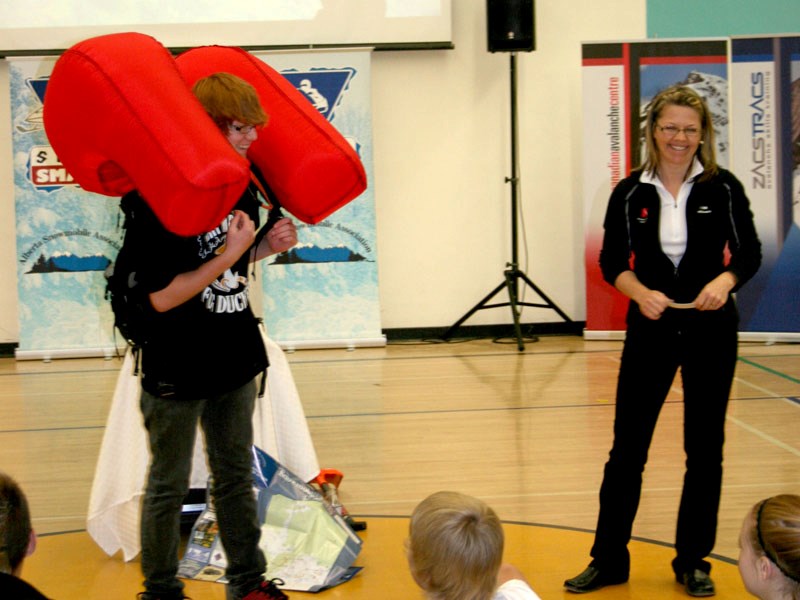A group of Barrhead students heard loud and clear that when you're playing with high-powered, fast and potentially dangerous machinery like a snowmobile or all-terrain vehicle, making smart decisions and acting responsibly is the difference between having a wonderful time or ending up seriously injured.
Lori Zakaruk, a safety instructor with the Alberta Snowmobile Association and owner of Zacstracs Avalanche Skills Training, spent a full day at Barrhead Composite High School Nov. 3 talking to hundreds of students about motorized sport safety.
Considering between 80 and 90 per cent of rural Alberta teenagers own or operate an ATV and/or snowmobile, educational safety courses like the one she teaches are invaluable, said Zakaruk, who detailed to students her recent passion of competing in numerous motorized sporting competitions across Western Canada.
Telling teenagers to stay away from ATVs and snowmobiles in this part of Canada would be foolhardy as it is a part of the culture, Zakurak said.
But telling them the consequences of irresponsible behaviour and failure to take precautionary measures whenever operating these powerful machines is a challenge she enjoys.
"I'm here to talk to the kids about making proper choices and decisions to ensure they can enjoy these activities safely," she said. "This is rural Alberta and almost every kid either owns or has access to a quad or snowmobile. It's not about scaring them, but telling them they have certain responsibilities to ensure they are safe while having a great time."
Zakaruk said she likes to catch the attention of the students by detailing her success as a competitive racer in mud bogs and snow cross.
"They can see that I love these sports as much as they do and that catches their attention," she said. "I do this because I truly enjoy the privilege of running this heavy equipment in a competitive atmosphere.
"It's a great way to enjoy nature and meet some wonderful people, but we can't we're dealing with teenagers and children ... we don't want to deny them the opportunity to enjoy wonderful experiences, but we have to recognize they are young and don't have a lot of experience and can get into serious trouble by making bad decisions.
"It's about learning your machine and your sport, making safety a priority and always making smart decisions to stay safe."
Zakaruk started off her hour-long presentation - one of four scheduled that day - to Grade 9 students emphasizing the importance of combining fun with safety.
"You always want to have fun in most things you do ... it doesn't matter if you're riding a sled, doing dishes or washing the floor," she said. "But you always want to play safe because I want every one of you in here to live a long, long life."
Operating a quad or sled isn't about knowing how to steer and turn on the ignition, but also about knowing your terrain and all possible hazards during any trip, Zakurak said.
When asked to point out possible hazards in any farmer's field, students yelled out fences, trees, animals and rough terrain must all be considered and looked for.
Zakaruk applauded the students for recognizing there are numerous hazards during any excursion in rural Alberta and how it's vitally important to always be cautious of those hazards.
"Any hazard that can impact your machine can cause you to hit the handlebars or fly over the handlebars and this can cause serious injury," she said.
Wearing a helmet and having it tightly secured remains the most important and crucial safety prevention measure any operator of a quad or sled must use, she told the students.
She also warned students to stay out of ditches whenever possible when operating sleds or quads except to access trails.
"Ditches are one of the most dangerous places to be ... there are many hazards there, like culverts, you often can't see," she said. "Stay away from ditches if at all possible."
About 15 minutes of her presentation centred on her personal expertise in avalanche protection and equipment on the market today available to conduct a rescue if any of the students are ever involved in an avalanche.
"You need to learn the rules of the mountain," she said.
She showed off equipment like avalanche beacons, which emit a signal which enables outdoor enthusiasts to track people buried beneath snow and shovels which can not only rapidly remove snow, but also be used as a saw should someone get trapped near a tree.
She also showed off avalanche probes used to detect the depth of people buried under snow.
"It's very important that you have all the tools you might need before you go" to an area where avalanche potential exists, she said.
The most important message she can preach to people of all ages - but especially inexperienced youth - is to exercise caution and always be aware of your surroundings and potential hazards when operating heavy motorized vehicles, said Zakaruk.
"Accidents don't just happen," she said. "They are the result of a whole series of choices. If you make the right choices and make safety your top priority, you can avoid dangerous situations. If we avoid making mistakes, we can avoid accidents."
She also urged students to always respect landowner's rights.
Property owners in rural Alberta are usually extremely generous when it comes to allowing outdoors lovers to enjoy quadding and sledding, but that changes if there is excessive noise and/or property damage, she said.
"Use your head before you plan any activity and think ahead and you can avoid almost all potential problems," she said.
Zakaruk said she speaks to more than 5,000 students each year as part of her job with the Alberta Snowmobile Association and hundreds more as an avalanche expert.
If the information she shares saves one life or young person from being critically injured, then she's making a difference and that's why she loves her job so much, she said.



